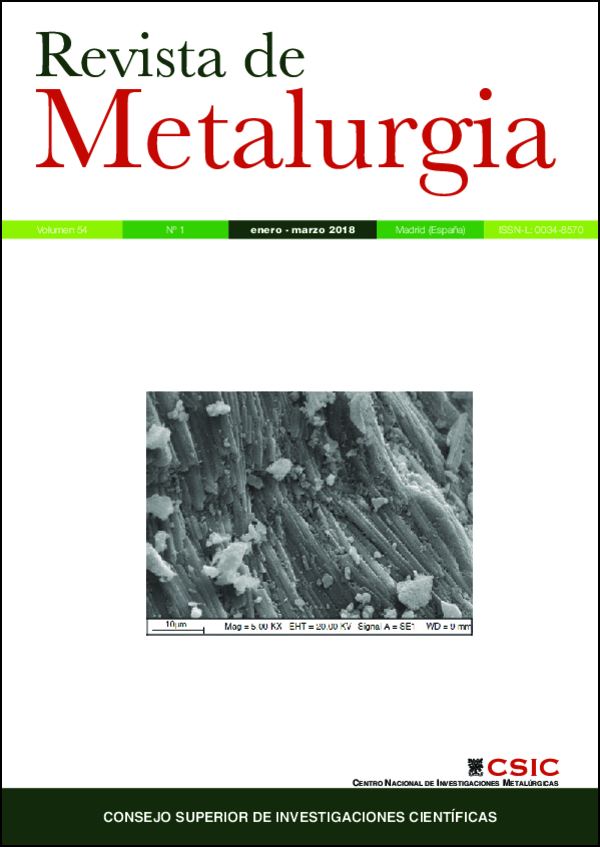Dissolution kinetics of calcined ulexite in ammonium sulfate solutions
DOI:
https://doi.org/10.3989/revmetalm.112Keywords:
Ammonium sulfate, Dehydration, Dissolution kinetics, UlexiteAbstract
Ulexite is one of the boron minerals, which include a respectable amount of hydration water. It can be used as a raw material in the production of boron compounds. Some part of water in the composition of ulexite can be removed from the solid matrix applying dehydration treatment, and a porous structure can be obtained to increase the reaction rate. In the present study, the effect of dehydration temperature on dissolution kinetics of ulexite in ammonium sulfate solutions was researched in a batch reactor utilizing the parameters of solution concentration, solid-to-liquid ratio, stirring speed and reaction temperature. It was determined that the dissolution rate of calcined material increased with increasing solution concentration and reaction temperature and with decreasing solid-to-liquid ratio. The highest dissolution rate was attained with the sample calcined at 150 °C. It was found that the dissolution rate fit to the first order pseudo-homogeneous model. The activation energy of the dissolution process was estimated to be 42 kJ·mol-1.
Downloads
References
Alkan, M., Çifçi, C., Ayaz, F., Dogˇan, M. (2000). Dissolution kinetics of ulexite in aqueous EDTA solutions. Can. Metall. Quart. 39 (4), 433–440. https://doi.org/10.1179/cmq.2000.39.4.433
Alkan, M., Dogˇan, M., Namli, H. (2004). Dissolution kinetics and mechanism of ulexite in oxalic acid solutions. Ind. Eng. Chem. Res. 43 (7), 1591–1598. https://doi.org/10.1021/ie0302746
Biyikogˇlu, A., Yeksan, E. (2008). Production of anhydrous borax from borax pentahydrate Int. J. Hydrogen Energ. 33 (23), 7103-7109. https://doi.org/10.1016/j.ijhydene.2008.09.006
Bulutçu, A.N., Ertekın, C.O., Kuskay Celıkoyan, M.B. (2008). Impurity control in the production of boric acid from colemanite in the presence of propionic acid. Chem. Eng. Process. 47 (12), 2270–2274. https://doi.org/10.1016/j.cep.2007.12.012
Çelik, M.S., Uzunoglu, H.A., Arslan, F. (1994). Decrepitation properties of some boron minerals. Powder Technol. 79 (2), 167?172. https://doi.org/10.1016/0032-5910(94)02811-7
Demirkıran, N. (2007). Leaching kinetics of calcined ulexite in ammonium nitrate solutions. J. Chem. Eng. Jpn. 40 (9), 755–760. https://doi.org/10.1252/jcej.07WE027
Demirkıran, N. (2008). A study on dissolution of ulexite in ammonium acetate solutions. Chem. Eng. J. 141 (1–3), 180–186. https://doi.org/10.1016/j.cej.2007.12.012
Demirkıran, N. (2009). Dissolution kinetics of ulexite in ammonium nitrate solutions. Hydrometallurgy 95 (3–4), 198–202. https://doi.org/10.1016/j.hydromet.2008.05.041
Demirkıran, N., Künkül, A. (2008). Dissolution kinetics of ulexite prepared under different calcination temperatures. Braz. J. Chem. Eng. 25 (4), 751–758. https://doi.org/10.1590/S0104-66322008000400012
Demirkıran, N., Bayrakçı, N., Asin, C. (2013). Dissolution of thermally dehydrated ulexite in ammonium acetate solutions. T. Nonferr. Metal. Soc. China 23 (6), 1797–1803. https://doi.org/10.1016/S1003-6326(13)62663-1
Ekmekyapar, A., Künkül, A., Demirkıran, N. (2010). Kinetic investigation of reaction between mineral ulexite and citric acid. Min. Proc. Ext. Met. Rev. 31 (4), 250–255. https://doi.org/10.1080/08827508.2010.508961
Erdogˇan, Y., Zeybek, A., S¸ahin, A., Demirbas¸, A. (1999). Dehydration kinetics of howlite, ulexite, and tunellite using thermogravimetric data. Thermochim. Acta 326 (1–2), 99–103. https://doi.org/10.1016/S0040-6031(98)00591-7
Ers¸ahan, H., Tunç, M., Ekmekyapar, A., Yapıcı, S. (1995). Flash dehydration of ulexite and investigation of dehydration kinetics from thermogravimetric data. Thermochim. Acta 250 (1), 125–135. https://doi.org/10.1016/0040-6031(94)01978-P
Flores, H.R., Valdez, S.K. (2007). Thermal requirements to obtain calcined and frits of ulexite. Thermochim. Acta 452 (1), 49–52. https://doi.org/10.1016/j.tca.2006.10.007
Künkül, A., Demirkıran, N. (2007). Dissolution kinetics of calcined ulexite in ammonium carbonate solutions. Korean J. Chem. Eng. 24 (6), 947–952. https://doi.org/10.1007/s11814-007-0103-x
Künkül, A., Tunç, M., Yapıcı, S., Ers¸ahan, H., Kocakerim, M.M. (1997). Dissolution of thermally dehydrated ulexite in sulfuric acid solution. Ind. Eng. Chem. Res. 36 (11), 4847–4851. https://doi.org/10.1021/ie9702136
Künkül, A., Aslan, N.E., Ekmekyapar, A., Demirkıran, N. (2012). Boric acid extraction from calcined colemanite with ammonium carbonate solutions. Ind. Eng. Chem. Res. 51 (9), 3612–3618. https://doi.org/10.1021/ie202388x
Levenspiel, O. (1972). Chemical Reaction Engineering. John Wiley, New York.
S¸ahin, S. (2002). A mathematical relationship for the explanation of ion exchange for boron adsorption. Desalination 143 (1), 35–43. https://doi.org/10.1016/S0011-9164(02)00219-9
S¸ener, S., Özbayogˇlu, G. (1995). Separation of ulexite from colemanite by calcination. Miner. Eng. 8 (6), 697–704. https://doi.org/10.1016/0892-6875(95)00030-T
S¸ener, S., Özbayogˇlu, G., Demirci, S¸. (2000). Changes in the structure of ulexite on heating. Thermochim. Acta 362 (1–2), 107-112. https://doi.org/10.1016/S0040-6031(00)00584-0
Taylan, N., Gürbüz, H., Bulutcu, A.N. (2007). Effects of ultrasound on the reaction step of boric acid production process from colemanite. Ultrason. Sonochem. 14 (5), 633–638. https://doi.org/10.1016/j.ultsonch.2006.11.001 PMid:17175191
Tekin, G., Onganer, Y., Alkan, M. (1998). Dissolution kinetics of ulexite in ammonium chloride solution. Can. Metall. Quart. 37 (2), 91–97. https://doi.org/10.1179/cmq.1998.37.2.91
Tunç, M., Ers¸ahan, H., Yapici, S., Çolak, S. (1997). Dehydration kinetics of ulexite from thermogravimetric data. J. Therm. Anal. 48 (2), 403–411. https://doi.org/10.1007/BF01979284
Waclawska, I. (1998). Controlled rate thermal analysis of hydrated borates. J. Therm. Anal. Calorim. 53 (2), 519–532. https://doi.org/10.1023/A:1010101727380
Published
How to Cite
Issue
Section
License
Copyright (c) 2018 Consejo Superior de Investigaciones Científicas (CSIC)

This work is licensed under a Creative Commons Attribution 4.0 International License.
© CSIC. Manuscripts published in both the printed and online versions of this Journal are the property of Consejo Superior de Investigaciones Científicas, and quoting this source is a requirement for any partial or full reproduction.
All contents of this electronic edition, except where otherwise noted, are distributed under a “Creative Commons Attribution 4.0 International” (CC BY 4.0) License. You may read the basic information and the legal text of the license. The indication of the CC BY 4.0 License must be expressly stated in this way when necessary.
Self-archiving in repositories, personal webpages or similar, of any version other than the published by the Editor, is not allowed.
















